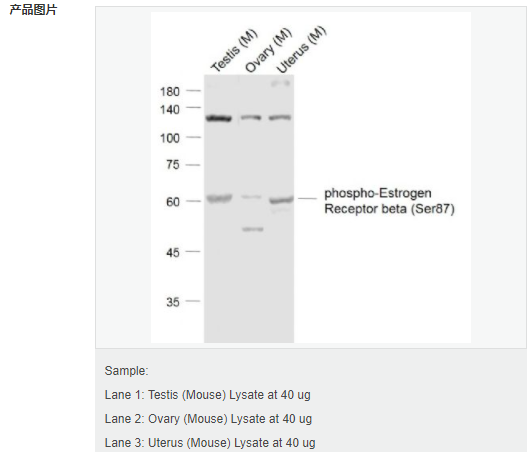

貨號
產(chǎn)品規(guī)格
售價
備注
BN41238R-100ul
100ul
¥2470.00
交叉反應(yīng):Mouse(predicted:Human,Rat,Rabbit,Sheep) 推薦應(yīng)用:WB,ELISA
產(chǎn)品描述
| 英文名稱 | phospho-Estrogen Receptor beta (Ser87) |
| 中文名稱 | 磷酸化雌激素受體β抗體 |
| 別 名 | Estrogen Receptor beta (phospho S87); Estrogen Receptor beta (phospho Ser87); p-ER beta(S87); p-ER beta(Ser87); phospho-ER-beta(Ser87); phospho-ER-beta(S87); Estrogen receptor-beta; ER BETA; ER-BETA; ER-beta; Erb; ESR 2; ESR 2; ESR B; ESR-B; ESR BETA; ESR-BETA; ESR2; ESR2; ESR2_HUMAN; ESRB; ESTRB; estrogen nuclear receptor beta variant a; estrogen nuclear receptor beta variant b; estrogen receptor 2 (ER beta); Estrogen Receptor 2; Estrogen Receptor-2; estrogen receptor beta 4; Estrogen receptor beta; NR3A2; Nuclear receptor subfamily 3 group A member 2. |
| 產(chǎn)品類型 | 磷酸化抗體 |
| 研究領(lǐng)域 | 腫瘤 細胞生物 免疫學 染色質(zhì)和核信號 信號轉(zhuǎn)導 轉(zhuǎn)錄調(diào)節(jié)因子 |
| 抗體來源 | Rabbit |
| 克隆類型 | Polyclonal |
| 交叉反應(yīng) | Mouse, (predicted: Human, Rat, Rabbit, Sheep, ) |
| 產(chǎn)品應(yīng)用 | WB=1:500-2000 ELISA=1:5000-10000 not yet tested in other applications. optimal dilutions/concentrations should be determined by the end user. |
| 分 子 量 | 66kDa |
| 細胞定位 | 細胞核 |
| 性 狀 | Liquid |
| 濃 度 | 1mg/ml |
| 免 疫 原 | KLH conjugated synthesised phosphopeptide derived from human Estrogen Receptor beta around the phosphorylation site of Ser87:HL(p-S)PL |
| 亞 型 | IgG |
| 純化方法 | affinity purified by Protein A |
| 儲 存 液 | 0.01M TBS(pH7.4) with 1% BSA, 0.03% Proclin300 and 50% Glycerol. |
| 保存條件 | Shipped at 4℃. Store at -20 °C for one year. Avoid repeated freeze/thaw cycles. |
| PubMed | PubMed |
| 產(chǎn)品介紹 | Estrogen receptors (ER) are members of the steroid/thyroid hormone receptor superfamily of ligand-activated transcription factors. Estrogen receptors, including ER alpha and ER beta, contain DNA binding and ligand binding domains and are critically involved in regulating the normal function of reproductive tissues. ER alpha and ER beta A have been shown to be differentially activated by various ligands. Receptor-ligand interactions trigger a cascade of events, including dissociation from heat shock proteins, receptor dimerization, phosphorylation and the association of the hormone activated receptor with specific regulatory elements in target genes. Evidence suggests that ER alpha and ER beta may be regulated by distinct mechanisms even though they share many functional characteristics. Function: Nuclear hormone receptor. Binds estrogens with an affinity similar to that of ESR1, and activates expression of reporter genes containing estrogen response elements (ERE) in an estrogen-dependent manner. Isoform beta-cx lacks ligand binding ability and has no or only very low ere binding activity resulting in the loss of ligand-dependent transactivation ability. DNA-binding by ESR1 and ESR2 is rapidly lost at 37 degrees Celsius in the absence of ligand while in the presence of 17 beta-estradiol and 4-hydroxy-tamoxifen loss in DNA-binding at elevated temperature is more gradual. Subunit: Binds DNA as a homodimer. Can form a heterodimer with ESR1. Interacts with NCOA3, NCOA5 and NCOA6 coactivators, leading to a strong increase of transcription of target genes. Interacts with PELP1 and UBE1C. Isoform beta-2/cx preferentially forms a heterodimer with ESR1 rather than ESR2 and inhibits DNA-binding by ESR1. Interacts with AKAP13. Interacts with DNTTIP2. Interacts with isoform 4 of TXNRD1. Interacts with CCDC62 in the presence of estradiol/E2; this interaction seems to enhance the transcription of target genes, including cyclin-D1/CCND1 AP-1 promoter. Interacts with DYX1C1. Interacts with PRMT2. Subcellular Location: Nucleus. Tissue Specificity: Tissue specificityIsoform beta-1 is expressed in testis and ovary, and at a lower level in heart, brain, placenta, liver, skeletal muscle, spleen, thymus, prostate, colon, bone marrow, mammary gland and uterus. Also found in uterine bone, breast, and ovarian tumor cell lines, but not in colon and liver tumors. Isoform beta-2 is expressed in spleen, thymus, testis and ovary and at a lower level in skeletal muscle, prostate, colon, small intestine, leukocytes, bone marrow, mammary gland and uterus. Isoform beta-3 is found in testis. Isoform beta-4 is expressed in testis, and at a lower level in spleen, thymus, ovary, mammary gland and uterus. Isoform beta-5 is expressed in testis, placenta, skeletal muscle, spleen and leukocytes, and at a lower level in heart, lung, liver, kidney, pancreas, thymus, prostate, colon, small intestine, bone marrow, mammary gland and uterus. Not expressed in brain. Similarity: Belongs to the nuclear hormone receptor family. NR3 subfamily. Contains 1 nuclear receptor DNA-binding domain. SWISS: Q92731 Gene ID: 2100 Database links: Entrez Gene: 2100 Human Entrez Gene: 13983 Mouse Omim: 601663 Human SwissProt: Q92731 Human SwissProt: O08537 Mouse Unigene: 660607 Human Important Note: This product as supplied is intended for research use only, not for use in human, therapeutic or diagnostic applications. |

